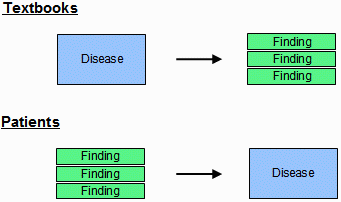Medical Education
Making explicit the process of differential diagnosis
It is often difficult to convey to medical students the art by which experienced doctors generate a differential diagnosis and mull over the possibilities. The software expresses this process in a very concrete form, making it very explicit to students. An example can be seen in this demo video.
Stressing the importance of taking a good history and doing a good physical examination
Trainees often focus on learning each and every disease, a quest that becomes more difficult with each passing year. This approach, of course, is inadequate because while textbooks teach the findings in individual diseases, patients show up with collections of findings and a doctor must put those together to reach a diagnosis:

Senior clinicians have long advised that the important skill is eliciting the findings: taking a good history and doing a good physical examination. Using the software makes this point explicit by allowing trainees to begin from physical findings and generate a differential diagnosis. Furthermore, it helps focus on the importance of the findings by suggesting useful findings to check and offering tips about how to distinguish one finding from another. This approach is being used in the Child Neurology Society's case-based education for neurology residents, using the SimulConsult software.
Training to avoid cognitive errors in diagnosis
Jerome Groopman MD wrote a best selling book "How doctors think", focusing on how doctors make cognitive errors in diagnosis. An article in Acta Paediatrica "How doctors think, and how software can help avoid cognitive errors in diagnosis" uses the SimulConsult software to illustrate how a systematic process such as using software tools in diagnosis can avoid such cognitive errors.
Providing feedback on the importance of the examination and lab tests
The software provides real-time feedback on the various signs, symptoms and lab tests entered about a particular patient by rating their importance in determining the differential diagnosis. As an example, the importance display on the "Patient's findings" tab from the case in this demo video documents how the physical findings present and absent had far more importance (shown as green bars) in making the diagnosis than the bone X-ray that was ordered:

Some of these points are discussed in more detail in a video interview about educational use of SimulConsult Diagnostic Decision Support by Michael Rosengarten MD, Associate Dean of Continuing Medical Education, McGill University School of Medicine, where SimulConsult is included on their list of educational resources.
Disseminating information about findings and diseases
SimulConsult has resources pages about all the findings and diseases in its database, including calculators and links to many articles. Resources available to the general public are listed here.
